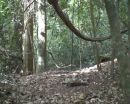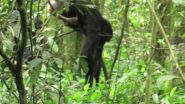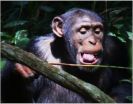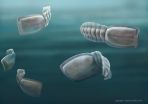(Press-News.org) VIDEO:
This video shows a chimpanzee who has constructed a tool with which to investigate a camera (Nimba mountains, Guinea).
Click here for more information.
West African chimpanzees will search far and wide to find Alchornea hirtella, a spindly shrub whose straight shoots provide the ideal tools to hunt aggressive army ants in an ingenious fashion, new research shows.
The plant provides the animals with two different types of tool, a thicker shoot for 'digging' and a more slender tool for 'dipping'.
On locating an army ant colony, chimpanzees will dig into the nest with the first tool - aggravating the insects. They then dip the second tool into the nest, causing the angry ants to swarm up it. Once the slender shoot is covered in ants, the chimpanzees pull it out and wipe their fingers along it: scooping up the ants until they have a substantial handful that goes straight into the mouth in one deft motion.
This technique - 'ant dipping' - was previously believed to be a last resort for the hungry apes, only exploited when the animal's preferred food of fruit couldn't be found. But the latest study, based on over ten years of data, shows that, in fact, army ants are a staple in the chimpanzee diet - eaten all year round regardless of available sources of fruit. Ants may be an important source of essential nutrients not available in the typical diet, say researchers, as well as a potential source of protein and fats.
The new research, published today in the American Journal of Primatology, was led by Dr Kathelijne Koops from the University of Cambridge's Division of Biological Anthropology and Junior Research Fellow of Homerton College.
VIDEO:
This video shows a male chimpanzee looking on at a female who is using an ant-dipping tool (Kalinzu Forest, Uganda).
Click here for more information.
"Ant dipping is a remarkable feat of problem-solving on the part of chimpanzees," said Koops. "If they tried to gather ants from the ground with their hands, they would end up horribly bitten with very little to show for it. But by using a tool set, preying on these social insects may prove as nutritionally lucrative as hunting a small mammal - a solid chunk of protein."
Koops points out that if Alchornea hirtella is nowhere to be found, chimps will fashion tools from other plants - but seemingly only after an exhaustive search for their preferred tool provider.
Previous research has shown that chimpanzees will actually select longer tools for faster, more aggressive types of army ants. The average 'dipping' tool length across the study was 64 centimetres, but dipping tools got up to 76 cm.
The question for Koops is one of animal culture: how do chimpanzees acquire knowledge of such sophisticated techniques?
"Scientists have been working on ruling out simple environmental and genetic explanations for group differences in behaviours, such as tool use, and the evidence is pointing strongly towards it being cultural," said Koops. "They probably learn tool use behaviours from their mother and others in the group when they are young."
The research for the ant-dipping study - which took place in Guinea's Nimba mountains - proved challenging, as the chimpanzees were not habituated to people - so the team acted almost as archaeologists, studying 'exploited' ants nests to measure abandoned tool sets and "sifting through faeces for ants heads".
To further study these illusive creatures, Koops set up cameras to take extensive video footage of the chimpanzees and their tool use. In doing so, she managed to capture a chimpanzee who has constructed a tool with which to investigate the camera itself - prodding it curiously and then sniffing the end of the tool (VIDEO 1).
"This study is part of a big ongoing research project. The next stages will involve looking at social opportunities to learn: how much time do youngsters spend within arm's length of other individuals; how much time do they spend close to their mother; as well as innate predispositions to explore and engage with objects," said Koops.
A video clip from the Kalinzu Forest in Uganda, where Koops is currently conducting comparative studies on East African chimpanzees, captures a male chimpanzee seemingly looking on enviously at a female who has managed to construct a much better dipping tool than his own and is feasting heartily as a consequence (VIDEO 2). Koops suggests this kind of observing of other individuals may lead to learning within a chimpanzee community.
"By studying our closest living relatives we gain a window into the evolutionary past which allows us to shed light on the origins of human technology and material culture,'' added Koops.
A link to the paper can be found here: http://onlinelibrary.wiley.com/journal/10.1002/(ISSN)1098-2345/earlyview
INFORMATION:
COLUMBUS, Ohio—Our view of other solar systems just got a little more familiar, with the discovery of a planet 25,000 light-years away that resembles our own Uranus.
Astronomers have discovered hundreds of planets around the Milky Way, including rocky planets similar to Earth and gas planets similar to Jupiter. But there is a third type of planet in our solar system—part gas, part ice—and this is the first time anyone has spotted a twin for our so-called "ice giant" planets, Uranus and Neptune.
An international research team led by Radek Poleski, postdoctoral ...
This news release is available in German. Public spending appears to have contributed substantially to the fact that life expectancy in eastern Germany has not only increased, but is now almost equivalent to life expectancy in the west. While the possible connection of public spending and life expectancy has been a matter of debate, scientists at the Max Planck Institute for Demographic Research (MPIDR) have now for the first time quantified the effect. They found that for each additional euro the eastern Germans received in benefits from pensions and public health ...
VIDEO:
Fruit fly border cells form clusters of six to eight cells, which display directional migration during oogenesis. Migration of border cells in egg chambers can be examined in detail by...
Click here for more information.
Cell migration is important for development and physiology of multicellular organisms. During embryonic development individual cells and cell clusters can move over relatively long distances, and cell migration is also essential for wound healing and many ...
Researchers from the University of Sheffield have found vital new evidence on how to target and reverse the effects caused by one of the most common genetic causes of Parkinson's.
Mutations in a gene called LRRK2 carry a well-established risk for Parkinson's disease, however the basis for this link is unclear.
The team, led by Parkinson's UK funded researchers Dr Kurt De Vos from the Department of Neuroscience and Dr Alex Whitworth from the Department of Biomedical Sciences, found that certain drugs could fully restore movement problems observed in fruit flies carrying ...
CORVALLIS, Ore. – Since the first undersea methane seep was discovered 30 years ago, scientists have meticulously analyzed and measured how microbes in the seafloor sediments consume the greenhouse gas methane as part of understanding how the Earth works.
The sediment-based microbes form an important methane "sink," preventing much of the chemical from reaching the atmosphere and contributing to greenhouse gas accumulation. As a byproduct of this process, the microbes create a type of rock known as authigenic carbonate, which while interesting to scientists was ...
Just 14 per cent of the population has an Advance Directive, or "living will", detailing their end of life treatment and care preferences, according to an article led by QUT Australian Centre for Health Law Research director Professor Ben White.
This research is from a joint University of Queensland, QUT and Victoria University study, supported by the Australian Research Council in partnership with seven public trustee organisations across Australia.
An Advance Directive is a legal document in which a person specifies what treatment or end of life care they want, when ...
ITHACA, N.Y. – Have you ever noticed you find your candidate for political office more attractive than the opponent? New research from Cornell University shows you're not the only one.
"We showed pictures of familiar and unfamiliar political leaders to voters in two different samples and found that familiarity and partisanship each significantly influenced how candidates were perceived," said the study's lead researcher, said Kevin M. Kniffin, a postdoctoral research associate at Cornell's Dyson School of Applied Economics and Management. "For example, Democrats ...
PULLMAN, Wash. – With global food demand expected to outpace the availability of water by the year 2050, consumers can make a big difference in reducing the water used in livestock production.
"It's important to know that small changes on the consumer side can help, and in fact may be necessary, to achieve big results in a production system," said Robin White, lead researcher of a Washington State University study appearing in the journal Food Policy.
WSU economist Mike Brady demonstrated that the willingness of consumers to pay a little more for meat products labeled ...
More than 100 years since they were first discovered, some of the world's most bizarre fossils have been identified as distant relatives of humans, thanks to the work of University of Adelaide researchers.
The fossils belong to 500-million-year-old blind water creatures, known to scientists as "vetulicolians" (pronounced: ve-TOO-lee-coal-ee-ans).
Alien-like in appearance, these marine creatures were "filter-feeders" shaped like a figure-of-8. Their strange anatomy has meant that no-one has been able to place them accurately on the tree of life, until now.
In a new ...
Philadelphia, PA, October 15, 2014 – Are deficits in attention limited to those with attention-deficit/hyperactivity disorder (ADHD) or is there a spectrum of attention function in the general population? The answer to this question has implications for psychiatric diagnoses and perhaps for society, broadly.
A new study published in the current issue of Biological Psychiatry, by researchers at Cardiff University School of Medicine and the University of Bristol, suggests that there is a spectrum of attention, hyperactivity/impulsiveness and language function in society, ...




